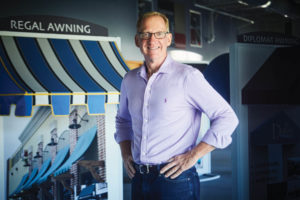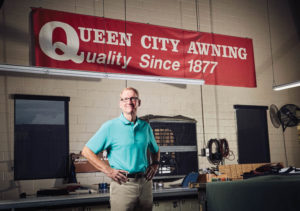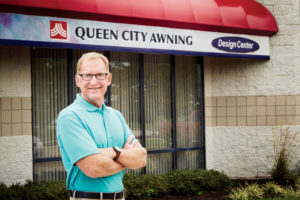
Even if projects are going well I try to improve them. I want to find a way to do things better; to do things faster,” says , president of Queen City Awning, Cincinnati, Ohio. “One of the ways I do that is by attending IFAI Expo and reading Specialty Fabrics Review magazine to keep up with what’s new.”
Weingartner’s grandfather purchased Queen City Awning in 1930, and his father Robert Weingartner, MFC, who later took the helm of the company, served two terms on IFAI’s board of directors, becoming an Honored Life Member of the association in 1999.
Like many who have grown up in family-run awning shops, Pete Weingartner was influenced by the entrepreneurial spirit of custom manufacturing. He earned a degree in industrial design and—true to that entrepreneurial spirit—went out into the world to work apart from the family business. “I wanted to see what was out there,” he says. “I started with a Fortune 500 company and found the work interesting, but also quickly found out that the hierarchies didn’t allow much control—and I wanted control over my destiny, so in late 1986 I came back to the family business.”
Weingartner came into the business at the height of the backlit awning craze. “It was a good time to get involved in the business,” he says. “For us, it was an entry into more signage and renovating buildings.”
Going once, going twice
Since then the industry has continued to change, including the ways awning companies garner business. Weingartner says bid sites have become an effective avenue to target growth for his company. He uses the sites to see what jobs are bidding that have products his company offers in their scope of work. “It’s a great way to be able to find projects, and you get a list of contractors that are bidding on the project so you can send your proposal to them,” he says. “If you didn’t win the bid, you can also track who ended up being awarded the project, so you can follow up with them to see how your bid may have compared with others.”
 Queen City Awning has been using bid sites for three or four years, ever since the company started receiving requests from local general contractors to bid on projects through the sites. Weingartner notes that the process has been successful on two levels. “One: it’s much easier to log onto an internet site to pull the information you need for a particular project as opposed to going into the contractor’s office,” he says. “Two: we’ve been able to bid work that perhaps we wouldn’t have been contacted for in the past, because either the contractors were from out of town working on an in-town project or the project itself was out of town. Bid sites have helped our business grow quite a bit.”
Queen City Awning has been using bid sites for three or four years, ever since the company started receiving requests from local general contractors to bid on projects through the sites. Weingartner notes that the process has been successful on two levels. “One: it’s much easier to log onto an internet site to pull the information you need for a particular project as opposed to going into the contractor’s office,” he says. “Two: we’ve been able to bid work that perhaps we wouldn’t have been contacted for in the past, because either the contractors were from out of town working on an in-town project or the project itself was out of town. Bid sites have helped our business grow quite a bit.”
Smart sourcing
Weingartner invites challenging projects—those that will broaden the company’s capabilities. “Getting involved in projects we may not be familiar with keeps the work interesting for all of us,” he says.
To take on projects outside his company’s typical scope of work, Weingartner outsources some elements to get it done, such as laser-cutting steel and certain fabrics, and powder-coating steel. A few years ago Queen City Awning took on a tension canopy project for a contractor the company had worked with previously, though his company hadn’t done a project like it before. “When we initially took the project on I had concerns—not if we could do it, but how we could do it,” Weingartner says. “It was a big learning curve, and we used some outside sources to get it done. It turned out well and now we’ve done more work along those lines.”
Working with outside vendors requires organization and communication skills—and a dose of educated trust. “Everybody’s got to understand their part in the project and you have to have a confidence level that the source can do what you need them to do,” Weingartner says. “And then if it’s their specialty, you need to let them run with it and not micromanage.”
Still, Weingartner cautions, you need to manage the project and keep all the players in the loop. “You have to make sure people are getting the information they need,” he says. “But with emails people don’t necessarily respond right away. Sometimes a phone call is better—you can talk to them directly.”
The benefit to the client is that they get a turn-key project from a provider they trust. “Sometimes it takes a lot of different vendors to get a project from design to completion and installation,” Weingartner adds.
Plan B
 Among the challenges of outsourcing, perhaps the most difficult is feeling confident that the vendors will deliver quality work, on time. Often, Weingartner relies on referrals, IFAI sources and others involved in the industry. “For the most part that works,” he says. “But sometimes you have to go to Plan B if for whatever reason they can’t deliver.”
Among the challenges of outsourcing, perhaps the most difficult is feeling confident that the vendors will deliver quality work, on time. Often, Weingartner relies on referrals, IFAI sources and others involved in the industry. “For the most part that works,” he says. “But sometimes you have to go to Plan B if for whatever reason they can’t deliver.”
For Weingartner, Plan B typically consists of moving onto the next vendor on the list—someone he has already vetted and has received a quote from. “I try to get quotes from several different vendors and compare them on price, and also which vendor might be more efficient and capable of getting the job done,” he says. “In the event that one vendor does have an issue—I have a backup.”
Closely held decisions
It’s a balance—making sure the products you provide meet or exceed the needs of the clients and avoiding the dreaded micromanagement trap that keeps CEOs and presidents from having a life. Queen City Awning has invested in strategic planning, and one of the takeaways for Weingartner is that decisions need to be made by the person most closely involved in the outcome. “When I initially got into business I thought that the person at the top made all the decisions,” he says. “Since then I’ve realized that it’s better to get it to the level where the person directly involved is making the decisions in as much as they can.
“And then following up, of course,” he says.
5 Top Tips for working with outside vendors
- Vet vendors through trusted sources.
- Make sure everyone involved understands their part in the project.
- Let people do their jobs. If it’s their specialty—let them run with it.
- Understand that everyone involved has to be able to come out whole, make a little money and feel good about the project.
- Manage the project, but don’t put so much pressure on vendors that they can’t perform as they need to.
Outdoors, rain or shine
When a local business that hosts wedding receptions and corporate events wanted to expand its outdoor space by installing a canopy, it called on Queen City Awning to make it happen. The client was interested in covering the outdoor space during exceptionally hot and/or rainy times, but also wanted to be able to retract the covering during nice weather. What made this project particularly challenging was that the 40-foot-wide by 60-foot-long canopy needed to attach to a one-story building, which meant that it wouldn’t be possible to slope the structure enough so rain would drain off. “The owner was really open to new ideas, so we were able to come up with a retractable canopy that worked for his space,” says Pete Weingartner, president of Queen City Awning.
What Weingartner and his team came up with was an arched design, comprised of four sections. The two end sections remain stationary and the two entry sections retract under the stationary sections. “It’s got the best of both elements,” Weingartner says. “The space can be protected during inclement weather and during
a nice day it can be opened up.”
How do you handle the question of metal awnings vs. fabric awnings?
You have to expand product offerings to meet the needs of clients, which can mean providing awnings and canopies made with other types of materials than fabrics. However, there is always going to be a need for fabric. Metal awnings can require altering the structure behind the building to support the weight, where a fabric awning can often just mount to the face of the building. And some projects require both metal and fabric, so it’s a benefit if you can provide both.
You have an employee who received an Industrial Fabrics Foundation (IFF) scholarship.
Tell us about him.
His name is Brad Curtis, and I believe he was one of the first recipients of the IFF scholarship in 2000. He started out at Queen City Awning in cutting and sewing and used the scholarship to further his education in business. Now he does a lot of our operations and coordinates production. We’re very proud of him.
 TEXTILES.ORG
TEXTILES.ORG


